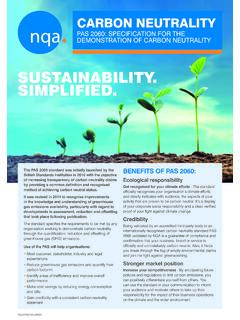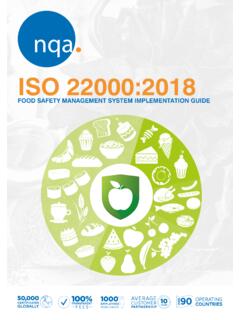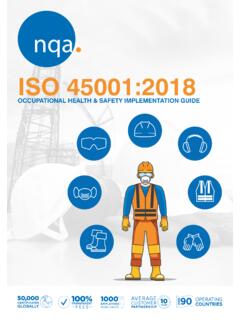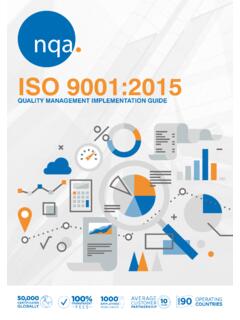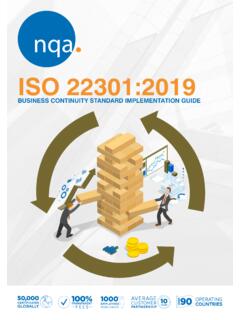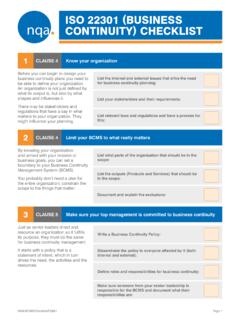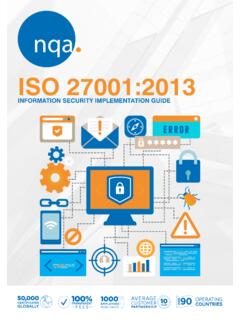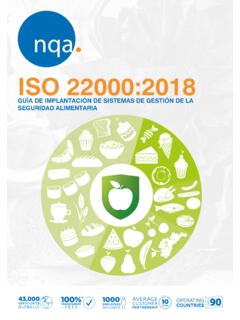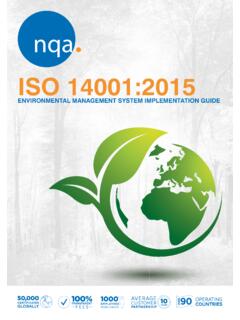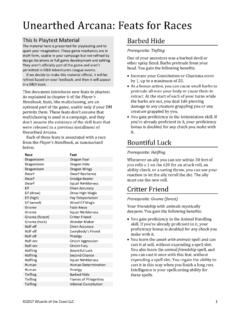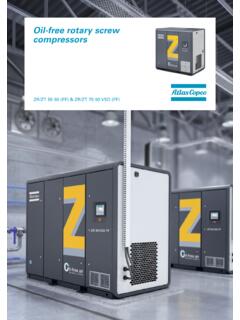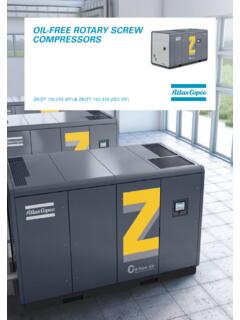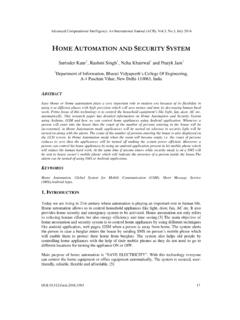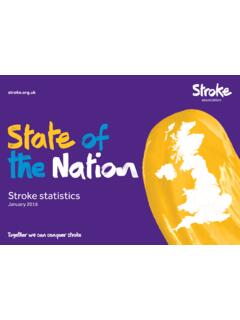Transcription of ISO 50001:2018 - NQA
1 ISO 50001:2018 energy MANAGEMENT SYSTEM IMPLEMENTATION GUIDE50,000 GLOBALLYCERTIFICATES90 TRANSPARENTISO 50001:2018 IMPLEMENTATION GUIDE2> ISO 50001:2018 IMPLEMENTATION GUIDEISO 50001:2018 IMPLEMENTATION GUIDE3 ContentsIntroduction to the standard P04 Benefits of implementation P05 Annex SL P06 PDCA cycle P07 Risk based thinking / audits P08 Process based thinking / audit P09 SECTION 1: Scope P10 SECTION 2: Normative references P10 SECTION 3: Terms and definitions P11 SECTION 4: Context of the organization P12 SECTION 5: Leadership P14 SECTION 6: Planning P16 SECTION 7: Support P20 SECTION 8: Operation P22 SECTION 9: Performance evaluation P24 SECTION 10: Improvement P28 Get the most from your management systems P29 energy Management Training P30 Next steps once implemented P32 Useful links P36 ISO 50001:2018 IMPLEMENTATION GUIDE4 INTRODUCTION TO THE STANDARDAs with other ISO management system standards, the energy management system (EnMS) in ISO 50001 is based on the Plan, Do, Check and Act framework.
2 It was first published in June 2011 and updated in August history of ISO 50001 The United Nations Industrial Development Organization (UNIDO) recognised that industry around the world needed to mount an effective response to climate change. It also noted a proliferation of national energy management standards including ones developed in China, Denmark, Ireland, Japan, Republic of Korea, Netherlands, Sweden, Thailand, USA and the European Union as a response to market demand for help with energy efficiency. In April 2007, a UNIDO stakeholders meeting decided to ask ISO to develop an international energy management standard.
3 ISO had identified energy management as one of its top five areas for the development of International Standards and, in 2008, created a project committee, ISO/PC 242 energy management , to carry out the work. ISO/PC 242 was led by ISO members for the United States and Brazil. In addition, its leadership included the ISO members for China and the United Kingdom to ensure that developed and developing economies participated together in the strategic direction and administration of the project committee. It was transformed into a technical committee in June 2011, signifying that it would be developing additional from the national standards bodies of 44 ISO member countries participated and another 14 countries were observers.
4 Development organizations including UNIDO and the World energy Council (WEC) were also 2012, the Lawrence D. Eicher (LDE) Leadership Award for excellence in creative and innovative standards development went to the ISO/TC 242 technical committee for the work that was carried out to publish the Standard in June 2011. At the time, it was estimated that the Standard could influence up to 60% of the world s energy EN ISO 50001:2018 energy management systems Requirements with guidance for use sets out an energy management framework for establishing policies, processes, procedures and specific energy -tasks to meet an organization s energy objectives.
5 It requires an organization to define its desired energy performance, and work towards achieving its stated objective(s). ISO 50001:2018 IMPLEMENTATION GUIDE5 BENEFITS OF IMPLEMENTATIONA FRAMEWORK TO MANAGE ENERGYAn effective EnMS that is aligned with an organization s business strategy, will allow visibility of how energy is being used and areas where performance can be improved. It provides the structured policies, processes, procedures and action plans to implement energy saving opportunities. Continual improvement in energy management is therefore REDUCTIONAny energy reductions identified through an EnMS will, in turn, offer demonstrable savings on energy bills, which will reduce the overhead of a business and in some cases substantially.
6 There are many examples of an organization undertaking the ISO 50001 process achieving first year energy cost savings which are equal to or greater than the initial costs of implementing the ENERGYCost reduction as identified in b) above and reducing energy , go hand in hand. By establishing, implementing, maintaining and continually improving an EnMS, an organization will be able to not only deal with the initial energy saving opportunities or low-hanging fruit but to identify and manage where, when and how energy is being consumed and identify energy efficiency improvements and reductions. CARBON REDUCTIONMany businesses report their output of carbon dioxide (CO2) or carbon footprint.
7 Whilst CO2 reduction cannot really be cited as a primary reason for achieving the ISO 50001 Standard, any reductions in energy will have a direct correlation with an organization s overall carbon ENGAGEMENTThe top down approach within ISO 50001 ensures that key senior stakeholders within the organization understand,as appropriate, its EnMS and are therefore motivated to achieve its objectives. ISO 50001 can be also be used to drive engagement on energy management; providing other members of an organization with a structured approach to managing energy 50001 requires an organization to establish a baseline to act as an indicator of energy performance.
8 By identifying a baseline, energy efficiency can be tracked over COMPLIANCES imilar to ISO 14001 and ISO 45001, ISO 50001 requires an organization to identify and have access to applicable legal and other requirements in relation to its energy efficiency, energy use, energy consumption and its EnMS. In the UK, ISO 50001 can be used to comply directly with the energy savings Opportunity Scheme (ESOS). The Government established ESOS to implement Article 8 (4 to 6) of the EU energy Efficiency Directive (2012/27/EU). In general ESOS applies to large UK undertakings and their corporate groups. It mainly affects businesses but can also apply to not-for-profit bodies and any other non public sector undertakings that are large enough to meet the qualification are required under ESOS to review the total energy use and energy efficiency of the organization and identify cost-effective energy savings opportunities by undertaking an energy audit.
9 However, if an organization has an EnMS certified to ISO 50001 then upon registration of the certification with the Environment Agency, direct compliance with ESOS is ISO 50001 can offer significant reputational benefits by demonstrating to an organization s stakeholders that it is fully committed to managing its energy consumption and seeking ways to increase its energy an organization gains certification, it can display the NQA logos on appropriate materials (in accordance with NQA/UKAS guidelines). This can not only publicise an organization s credentials (and perhaps provide a competitive edge) but can provide a short-hand info-graphic that energy governance is being is an ever increasing trend, that when seeking to supply goods and services to the business sector (particularly the Public Sector) accredited systems such as ISO 50001 are required, in order to meet pre contract procurement award criteria.
10 5 Whilst having a thought-out system to manage business processes are beneficial, there are specific benefits of implementing an EnMS which is certified to ISO 50001:ISO 50001:2018 IMPLEMENTATION GUIDE66 ANNEX SLAnnex SL takes the principles within Guide 83 and creates a universal high-level structure, identical core text, and common terms and definitions for all management system standards which make the integration of management systems when according to a particular Standard good use of Annex SL and an example of an integrated management system (IMS) is one that simultaneously handles the requirements of ISO 9001, ISO 14001 and ISO , the processes required in each Standard for document control, internal audits, dealing with nonconformities, corrective actions, or management review are shared, so that the requirements of each Standard are met without duplicating effort having three processes - one for ISO 9001, ISO 14001 and ISO SL provides the new common architecture for ISO Management System Standards.
